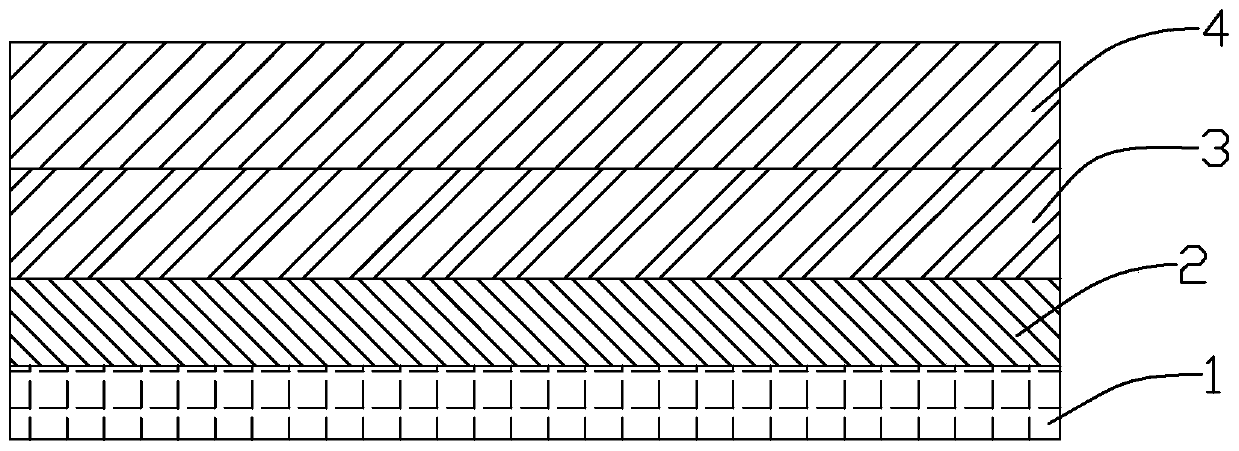Radiation-proof fabric and production process thereof
A production process and anti-radiation technology, which is applied to layered products, metal layered products, synthetic resin layered products, etc., can solve problems such as corrosion, radiation-proof fabrics and radiation-proof effects, and achieve avoidance of twisting effect, excellent Radiation protection effect, durability improvement effect
- Summary
- Abstract
- Description
- Claims
- Application Information
AI Technical Summary
Problems solved by technology
Method used
Image
Examples
Embodiment 1
[0039]A radiation-proof fabric, comprising a base fabric layer 1, the base fabric layer 1 is woven from cotton fibers, the base fabric layer 1 is provided with a fabric layer 4, and the fabric layer 4 is made of cotton fibers and polyamide fibers blended, wherein the cotton Fiber accounts for 80%, polyamide fiber accounts for 20%; a radiation protection layer 2 is arranged between the fabric layer 4 and the base fabric layer 1;
[0040] The radiation protection layer includes the following raw materials: 30kg of nano-silver fiber, 20kg of polyphenylene sulfide fiber, 10kg of bamboo fiber, 3kg of nano-barium sulfate, 2kg of nano-titanium dioxide, 1kg of lanthanum oxide, 4kg of polyacrylonitrile and 5kg of polyurethane.
[0041] The production technology of this anti-radiation fabric comprises the following steps:
[0042] Step 1. The base fabric layer is steamed and shaped. The steamed yarn setting temperature is 80°C, and the time is controlled at 60 minutes. Then, the raw mat...
Embodiment 2
[0044] A radiation-proof fabric, comprising a base fabric layer 1, the base fabric layer 1 is woven from cotton fibers, the base fabric layer 1 is provided with a fabric layer 4, and the fabric layer 4 is made of cotton fibers and polyamide fibers blended, wherein the cotton Fiber accounts for 80%, and polyamide fiber accounts for 20%. A radiation-proof layer 2 is arranged between the fabric layer 4 and the base fabric layer 1, and a breathable layer 3 is also arranged between the fabric layer 4 and the radiation-proof layer 2. The breathable layer 3 is made of hemp fiber woven;
[0045] The radiation protection layer includes the following raw materials: 35kg of nano-silver fiber, 15kg of polyphenylene sulfide fiber, 15kg of bamboo fiber, 4kg of nano-barium sulfate, 3kg of nano-titanium dioxide, 2kg of cerium oxide, 8kg of polyacrylonitrile and 10kg of polyurethane.
[0046] The production technology of this anti-radiation fabric comprises the following steps:
[0047] Step ...
Embodiment 3
[0050] A radiation-proof fabric, comprising a base fabric layer 1, the base fabric layer 1 is woven from cotton fibers, the base fabric layer 1 is provided with a fabric layer 4, and the fabric layer 4 is made of cotton fibers and polyamide fibers blended, wherein the cotton Fiber accounts for 80%, and polyamide fiber accounts for 20%. A radiation-proof layer 2 is arranged between the fabric layer 4 and the base fabric layer 1, and a breathable layer 3 is also arranged between the fabric layer 4 and the radiation-proof layer 2. The breathable layer 3 is made of hemp fiber woven;
[0051] The radiation protection layer includes the following raw materials: 40kg of nano-silver fiber, 16kg of polyphenylene sulfide fiber, 14kg of bamboo fiber, 5kg of nano-barium sulfate, 2kg of nano-titanium dioxide, 3kg of lanthanum acrylate, 6kg of polyacrylonitrile and 9kg of polyurethane.
[0052] The production technology of this anti-radiation fabric comprises the following steps:
[0053] ...
PUM
 Login to View More
Login to View More Abstract
Description
Claims
Application Information
 Login to View More
Login to View More - R&D
- Intellectual Property
- Life Sciences
- Materials
- Tech Scout
- Unparalleled Data Quality
- Higher Quality Content
- 60% Fewer Hallucinations
Browse by: Latest US Patents, China's latest patents, Technical Efficacy Thesaurus, Application Domain, Technology Topic, Popular Technical Reports.
© 2025 PatSnap. All rights reserved.Legal|Privacy policy|Modern Slavery Act Transparency Statement|Sitemap|About US| Contact US: help@patsnap.com


